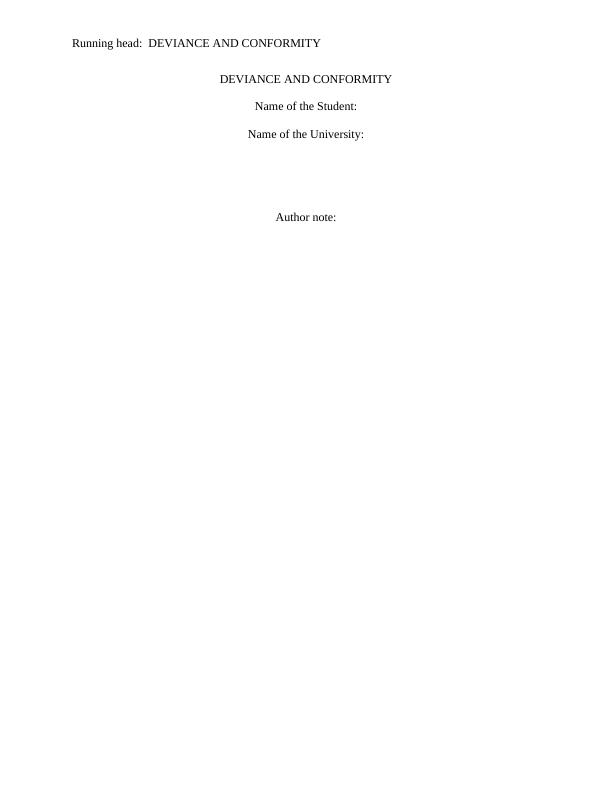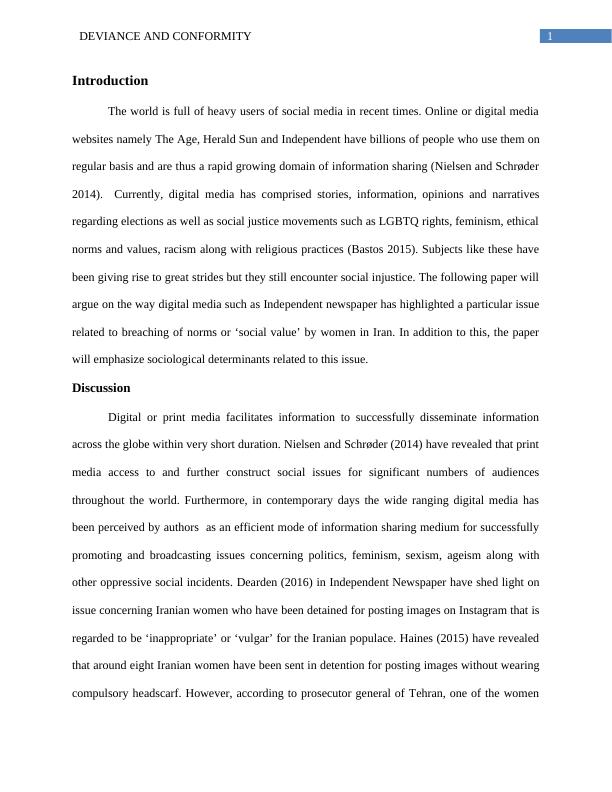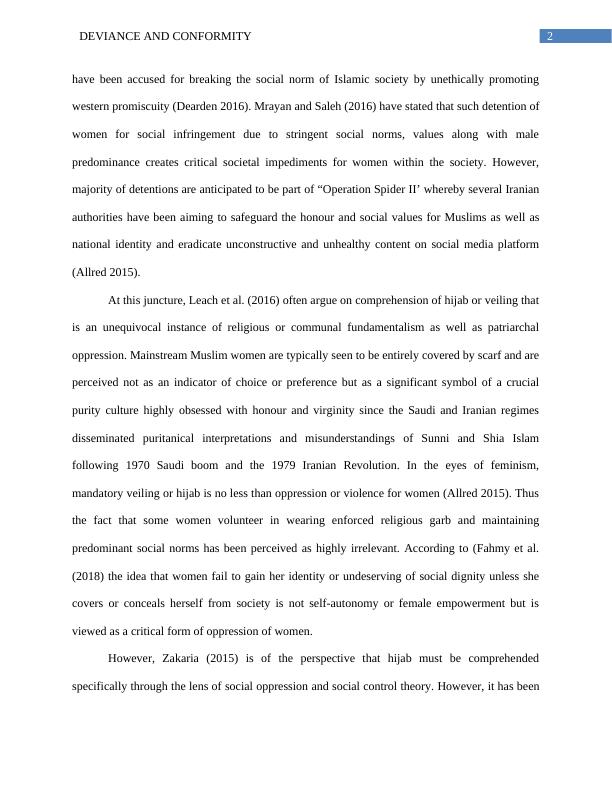Deviance and Conformity in Iranian Women: A Sociological Perspective
Added on 2023-05-30
9 Pages2176 Words166 Views
Running head: DEVIANCE AND CONFORMITY
DEVIANCE AND CONFORMITY
Name of the Student:
Name of the University:
Author note:
DEVIANCE AND CONFORMITY
Name of the Student:
Name of the University:
Author note:

1DEVIANCE AND CONFORMITY
Introduction
The world is full of heavy users of social media in recent times. Online or digital media
websites namely The Age, Herald Sun and Independent have billions of people who use them on
regular basis and are thus a rapid growing domain of information sharing (Nielsen and Schrøder
2014). Currently, digital media has comprised stories, information, opinions and narratives
regarding elections as well as social justice movements such as LGBTQ rights, feminism, ethical
norms and values, racism along with religious practices (Bastos 2015). Subjects like these have
been giving rise to great strides but they still encounter social injustice. The following paper will
argue on the way digital media such as Independent newspaper has highlighted a particular issue
related to breaching of norms or ‘social value’ by women in Iran. In addition to this, the paper
will emphasize sociological determinants related to this issue.
Discussion
Digital or print media facilitates information to successfully disseminate information
across the globe within very short duration. Nielsen and Schrøder (2014) have revealed that print
media access to and further construct social issues for significant numbers of audiences
throughout the world. Furthermore, in contemporary days the wide ranging digital media has
been perceived by authors as an efficient mode of information sharing medium for successfully
promoting and broadcasting issues concerning politics, feminism, sexism, ageism along with
other oppressive social incidents. Dearden (2016) in Independent Newspaper have shed light on
issue concerning Iranian women who have been detained for posting images on Instagram that is
regarded to be ‘inappropriate’ or ‘vulgar’ for the Iranian populace. Haines (2015) have revealed
that around eight Iranian women have been sent in detention for posting images without wearing
compulsory headscarf. However, according to prosecutor general of Tehran, one of the women
Introduction
The world is full of heavy users of social media in recent times. Online or digital media
websites namely The Age, Herald Sun and Independent have billions of people who use them on
regular basis and are thus a rapid growing domain of information sharing (Nielsen and Schrøder
2014). Currently, digital media has comprised stories, information, opinions and narratives
regarding elections as well as social justice movements such as LGBTQ rights, feminism, ethical
norms and values, racism along with religious practices (Bastos 2015). Subjects like these have
been giving rise to great strides but they still encounter social injustice. The following paper will
argue on the way digital media such as Independent newspaper has highlighted a particular issue
related to breaching of norms or ‘social value’ by women in Iran. In addition to this, the paper
will emphasize sociological determinants related to this issue.
Discussion
Digital or print media facilitates information to successfully disseminate information
across the globe within very short duration. Nielsen and Schrøder (2014) have revealed that print
media access to and further construct social issues for significant numbers of audiences
throughout the world. Furthermore, in contemporary days the wide ranging digital media has
been perceived by authors as an efficient mode of information sharing medium for successfully
promoting and broadcasting issues concerning politics, feminism, sexism, ageism along with
other oppressive social incidents. Dearden (2016) in Independent Newspaper have shed light on
issue concerning Iranian women who have been detained for posting images on Instagram that is
regarded to be ‘inappropriate’ or ‘vulgar’ for the Iranian populace. Haines (2015) have revealed
that around eight Iranian women have been sent in detention for posting images without wearing
compulsory headscarf. However, according to prosecutor general of Tehran, one of the women

2DEVIANCE AND CONFORMITY
have been accused for breaking the social norm of Islamic society by unethically promoting
western promiscuity (Dearden 2016). Mrayan and Saleh (2016) have stated that such detention of
women for social infringement due to stringent social norms, values along with male
predominance creates critical societal impediments for women within the society. However,
majority of detentions are anticipated to be part of “Operation Spider II’ whereby several Iranian
authorities have been aiming to safeguard the honour and social values for Muslims as well as
national identity and eradicate unconstructive and unhealthy content on social media platform
(Allred 2015).
At this juncture, Leach et al. (2016) often argue on comprehension of hijab or veiling that
is an unequivocal instance of religious or communal fundamentalism as well as patriarchal
oppression. Mainstream Muslim women are typically seen to be entirely covered by scarf and are
perceived not as an indicator of choice or preference but as a significant symbol of a crucial
purity culture highly obsessed with honour and virginity since the Saudi and Iranian regimes
disseminated puritanical interpretations and misunderstandings of Sunni and Shia Islam
following 1970 Saudi boom and the 1979 Iranian Revolution. In the eyes of feminism,
mandatory veiling or hijab is no less than oppression or violence for women (Allred 2015). Thus
the fact that some women volunteer in wearing enforced religious garb and maintaining
predominant social norms has been perceived as highly irrelevant. According to (Fahmy et al.
(2018) the idea that women fail to gain her identity or undeserving of social dignity unless she
covers or conceals herself from society is not self-autonomy or female empowerment but is
viewed as a critical form of oppression of women.
However, Zakaria (2015) is of the perspective that hijab must be comprehended
specifically through the lens of social oppression and social control theory. However, it has been
have been accused for breaking the social norm of Islamic society by unethically promoting
western promiscuity (Dearden 2016). Mrayan and Saleh (2016) have stated that such detention of
women for social infringement due to stringent social norms, values along with male
predominance creates critical societal impediments for women within the society. However,
majority of detentions are anticipated to be part of “Operation Spider II’ whereby several Iranian
authorities have been aiming to safeguard the honour and social values for Muslims as well as
national identity and eradicate unconstructive and unhealthy content on social media platform
(Allred 2015).
At this juncture, Leach et al. (2016) often argue on comprehension of hijab or veiling that
is an unequivocal instance of religious or communal fundamentalism as well as patriarchal
oppression. Mainstream Muslim women are typically seen to be entirely covered by scarf and are
perceived not as an indicator of choice or preference but as a significant symbol of a crucial
purity culture highly obsessed with honour and virginity since the Saudi and Iranian regimes
disseminated puritanical interpretations and misunderstandings of Sunni and Shia Islam
following 1970 Saudi boom and the 1979 Iranian Revolution. In the eyes of feminism,
mandatory veiling or hijab is no less than oppression or violence for women (Allred 2015). Thus
the fact that some women volunteer in wearing enforced religious garb and maintaining
predominant social norms has been perceived as highly irrelevant. According to (Fahmy et al.
(2018) the idea that women fail to gain her identity or undeserving of social dignity unless she
covers or conceals herself from society is not self-autonomy or female empowerment but is
viewed as a critical form of oppression of women.
However, Zakaria (2015) is of the perspective that hijab must be comprehended
specifically through the lens of social oppression and social control theory. However, it has been

End of preview
Want to access all the pages? Upload your documents or become a member.